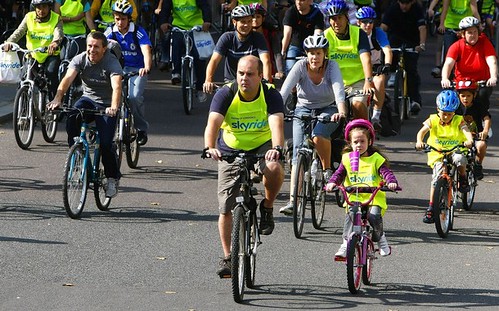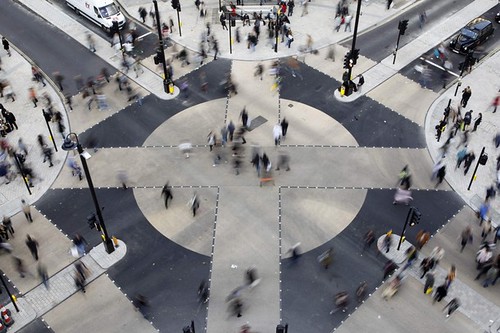It's not just sidewalks and money, spatial form and density influence the propensity to walk
One of the encouragement programs out there is based on the Bogota Ciclovia, when streets are closed to cars for a day on the weekend and programs promoting walking, health, and bicycling are offered.
I find these programs very interesting, even if DC's first version a couple months ago, held in a park miles away from the city's main population center, was quite timid. Britain's SkyRide, sponsored by Sky TV and the Mayor of London, is much more bold. Imagine your Mayor encouraging you to bicycle and walk, rather than being focused on himself.... (see "Fenty uses police escort, clogs traffic on bike rides" from WTOP)

LONDON, ENGLAND - SEPTEMBER 20: Cyclists take part in The Mayor of London's Skyride, a day of entertainment on traffic-free, city-centre streets on September 20, 2009 in London, England. The free, mass participation event organised by the Mayor of London in partnership with Sky, encouraged people of all ages and abilities back on their bikes this summer. The route took in iconic landmarks including Buckingham Palace, St Paul's Cathedral and The Tower of London and also incorporated St James Park and the river views of The Embankment. Visit www.goskyride.com for details. (Photo by Tom Dulat/Getty Images for Sky)
The 76-year old Darwin Hindman, the Mayor of Columbia, Missouri (Columbia is pretty progressive because it is a college town), is an avid cyclist recently featured in Parade Magazine, "A FreeWheeling City." He rides about 60 miles/week. He was in Columbia, Maryland last week, giving a talk on bicycling and quality of community life. See "Pedal pusher" from the Baltimore Sun. I wish I had a chance to get over and hear him speak.
Yes more "transportation" monies should be spent to support complete streets and placemaking, and promoting walking. See "Path to good health, less pollution is the sidewalk: report" via the Independent. From the article:
Designing towns and cities to make it more appealing and safer to walk or ride a bike would not only help fight the US obesity epidemic and improve health but would also reduce greenhouse gas emissions and air pollution, a report issued by the Surface Transportation Policy Partnership and Transportation for America said.
Currently, no state spends more than five percent of federal transportation funds on projects that could improve pedestrian and cyclist safety, such as building more sidewalks or "zebra crossings," the report said.
-- Dangerous by Design: Solving the Epidemic of Preventable Pedestrian Deaths (and Making Great Neighborhoods) report by Transportation for America
---------------
And I forgot to mention a similar report in Canada, "Urban sprawl no fun for kids, say reports," from the Calgary Herald. From the article:
Kids these days: they rarely walk anywhere. They don't ride bikes, they don't play outside — not like they used to, anyway. But can we blame them?
Not according to two new studies released by the Vanier Institute of the Family, a charitable Ottawa-based organization.
"The way that cities have evolved has been rather wrong-headed," said Katherine Scott, director of programs at the institute. "Lots of it has to do with urban sprawl."
The studies, released Tuesday, chronicle a generation of Canadian youngsters reared primarily in spread-out communities outside the urban centre, where they can expect to be driven anywhere they want to go, even if it's just to a friend's house a few blocks away. The data is based both on literature and empirical research, conducted over the past year, said Scott.
The reports:
- Children & Cities: Planning to Grow Together
- Caution! Kids at Play?
------------------
But it's not just a matter of putting sidewalks everywhere. Frankly, I wish it were that simple. This story is also covered in today's Post, "Pedestrian safety study ranks Washington area in the middle."
People's willingness to walk is a function of population and building density, (which in turn influences) the availability of "amenities" within walking distance (for example, Walkscore lists these types of businesses and civic assets as key destinations: Transit; Grocery Stores; Restaurants; Cafes & Bars; Movie Theaters; Schools; Recreation Centers; Libraries; Bookstores; Fitness Services; Pharmacies; Hardware Stores; and Clothing Stores).
The Walkscore where I live is 62. But between walking and transit, both the bus (a stop is 2.5 blocks away) and the subway (Takoma Metro is 0.8 miles away), not to mention bicycling, it is a walkable neighborhood, with schools, parks, and a micro-commercial district (two restaurants, food co-op, barber shop, dry cleaners and two boutiques + a variety of services, mostly daycare) two blocks away.
With some couple exceptions, the entire neighborhood street network is complemented with a complete sidewalk network on both sides of the street.
But few people walk, unless they have dogs or they don't have cars. Virtually every household drives.
But, we have sidewalks...
Appendix A of the DC Pedestrian Master Plan is the "Pedestrian Demand Methodology" which provides a useful tool for and way of thinking about judging the pedestrian potential of an area based on promixity to attractions and transit as well as residential and employment density. Density makes all the difference.
This is fundamental, because you have to prioritize investments in walking (and bicycling and transit) because there are limited funds, whether or not states fund pedestrian and bicycling improvements at a significant level.
To retrofit a typical county (suburban) street network with sidewalks, bicycle lanes, and a network of off-street trails, many hundreds of millions of dollars (!!!!!!!!!!!!!!!!!!!!!) is required due to the need to acquire right of way (land) to extend the width of the roadway (if this is even possible), plus the cost of widening roads for bicycle lanes, and adding sidewalks.
Note the figure. That is for one county. Maryland, a relatively small state, has 24 counties. (The county that I work in is struggling to come up with $500,000/year to dedicate to sidewalk and bicycle improvements--divide $500,000 into "hundreds of millions" and estimate how long it will take to make improvements. Of course, many of the main roads are under the control of the State Highway Administration, which does improve walking and bicycling environments when they rebuild roads.)
See "Md. pedestrian death rate called higher than national average" from the Baltimore Sun on the same story. From the article:
One of the worst states in that regard, according to the report, is Maryland, which the study ranks 49th among the 50 states in per capita spending of federal transportation funds on bicycling and walking projects. The study puts Maryland's per capita spending on such projects at 45 cents - compared with a national average of $1.46 and a high of $9.47 in Alaska. Only Virginia, with per capita spending of 22 cents, was ranked as more stingy toward walkers.
Douglas H. Simmons, deputy state highway administrator, said the report might be understating Maryland's commitment to such projects because the state has traditionally funded some pedestrian programs entirely out of its own Transportation Trust Fund.
But Dan Pontious, executive director of the Citizens Planning and Housing Association, said that in spite of some progress, transportation agencies cling to their old priorities.
"In the big picture, we're still really focused on moving cars, and there's much more progress to make to create vibrant, walkable communities," he said.
Plus, it is necessary to complement infrastructure improvements (what I call hard infrastructure) with other programs (what I call soft infrastructure, but in the trade is called education and encouragement) to get people out of their cars and on the sidewalks and streets.

Pedestrian cross the new diagonal crossing at Oxford Circus in London November 2, 2009. The design of the new 5 million ($8.2 million) pound crossing was inspired by the Shibuya crossing in Tokyo and allows pedestrians to cross diagonally. REUTERS/Stefan Wermuth.
Then of course, you get the safety side of the equation. All the safety improvements in the world have limited effect on reckless driving and/or stupid behavior.
Yes, traffic accidents involving bicyclists and/or pedestrians are indicators of problems, often design problems. But the truck driver who doesn't signal and then makes a right, into the path of a bicyclist ("Cycling community rides to honor one of its own" from the Baltimore Sun), killing him, isn't a design problem. It's something else entirely.
Labels: bicycling, car culture and automobility, transportation planning, urban design/placemaking, walking



0 Comments:
Post a Comment
<< Home